2022-05-12-Little-Moreton-Hall
Little Moreton Hall: A Remarkable Tudor Survivor
A talk by Mr. Trevor Wiliams.
On a beautiful spring evening our members and visitors were enthralled by a well illustrated talk on “Little Moreton Hall”
which is now a National Trust property, by a room steward Mr Trevor Williams.
The Speaker.
Mr. Williams acted as a room steward for 10 years up to Covid-19 closed all the National Trust properties to visitors in 2020.
Immediately after retirement he looked for something to do, saw a notice requesting volunteers for Little Moreton Hall, he
applied as a volunteer steward and became ‘addicted’ to the purpose of helping others appreciate the property.
He recommended that persons should join the National Trust as a good way of increasing their leisure facilities and
of course keeping the trust alive to serve as a caretaker of properties to the nation.
Details about the National Trust are at the end of this report.
Report on talk.
Your reporter could not do justice to the quality of the talk, and the incidences described to us about the people,
their wealth being used for land grabs from the dissolution of the monasteries, and religious houses, to create an
estate that subsequently was sold off as family fortunes declined, the hall becoming a tenant farmer’s house while
the land was rented, which this accidentality avoided ‘modernisation’ of the premises and thus possible loss of
this now Grade 1 Listed Building’, which survived in a very distressed state; but with a lot of funds,
voluntary effort and with old craft skills re-used is now re-stored to a state where we can enjoy it.
The National Trust Summary.
Visiting Little Moreton Hall A visit to this iconic Tudor manor house that will take your breath away with its wonky angles
and quirky character. Built to impress by craftsmen's hands more than 500 years ago, the hall, with its crooked walls
and uneven floors, may seem fragile but it's a remarkable survivor.
Location of Little Moreton Hall in Cheshire, England.
Co-ordinates: 53º 07’ 18” North 2º 15’ 07” West, on A34 between Congleton in the North and Kidgsgrove in the South
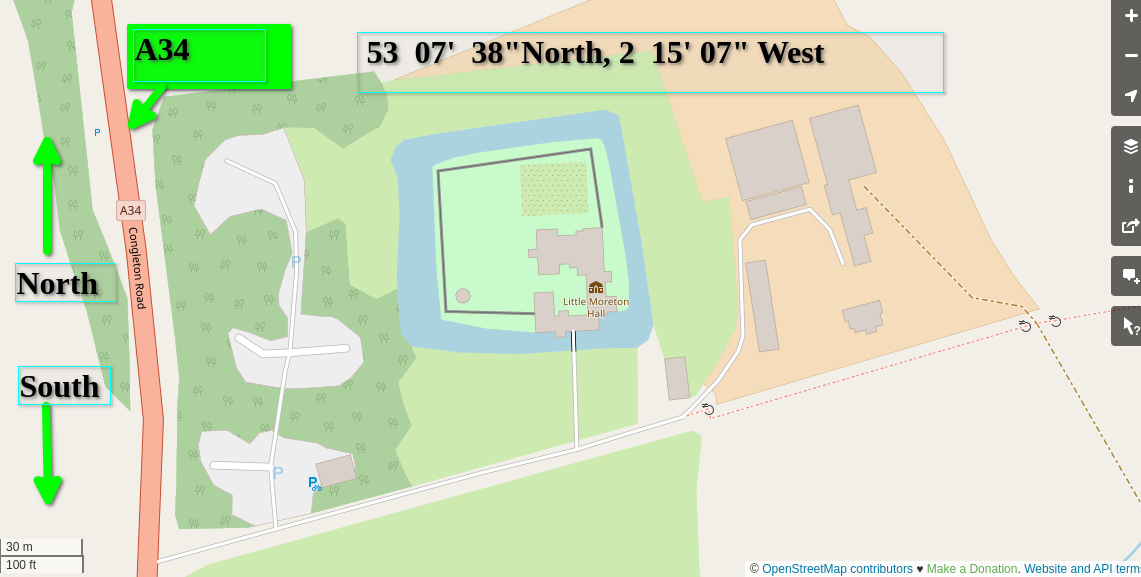
Maps courtesy of Open Street Map.
https://www.openstreetmap.org/
Note on Open Street Maps. OpenStreetMap® is open data, licensed under the Open Data Commons Open Database License (ODbL) by the OpenStreetMap Foundation (OSMF). You are free to copy, distribute, transmit and adapt our data, as long as you credit OpenStreetMap and its contributors. If you alter or build upon our data, you may distribute the result only under the same licence.
Why “Little” Moreton Hall.
Well, there was another "Great " or "Old" Moreton Hall at one time near it, also owned by the Moreton family
Discoveries.
During the extensive renovations made following an appeal for funds to preserve the property, many original building skills and materials had to be used as the ‘modern ways’ did not work and damaged the property.
The walls and support timbers are laid on sandstone blocks on the ground, so water dripping from modern concrete wall replacements just rotted the base timbers. Back to original wooden and infill walling to make the building secure.
Some original internal paint was discovered and the colour reused in the interior decoration.
Each of the major rooms is decorated and laid out to represent a different period in the hall’s history.
As the hall and its owners had a period of growth, wealth, neglect and loss of wealth, the neglect saved the original structure from ‘modern improvements’ of the later centuries and so we have a unique view and record the building as it was in use.
A very old tennis ball was discovered behind some wall panelling and is now in the national collection iof a London Museum.
TENNIS BALL IMAGE
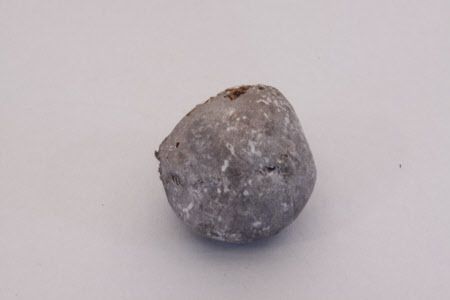
Images are from National Trust website collections Little Moreton Hall. ((c) National Trust)
National Trust Website link.
https://www.nationaltrust.org.uk/little-moreton-hall
Tudor Ritual Protection Marks
Tudor ritual protection marks are scattered throughout Little Moreton Hall
Fear and superstition
(extract from National Trust description)
In Tudor times there was a genuine belief in witches and the power of evil. The Tudors especially feared the night and the dark. From the time of Henry VIII and up to the Civil War and Commonwealth years, there was a period of religious turmoil. People felt they could no longer turn to the Church as a remedy for their worries, in the same way as they had done before. It was also a time when the North West region was affected by the Plague. Burn marks were likely one of the many things that people did to deal with their fears - they were a form of protection.
What has been found?
In 2014 two archaeologists found by experimentation that burn marks were not accidental but deliberate taper burns. Research volunteers at Little Moreton Hall have since discovered over 250 of these burn marks as well as two other types of marks; circle designs and criss-cross webs of lines. These marks have been found near windows, fireplaces, and blocked doorways. They have also been found in places where the building has been altered and where there is a hollow space behind walls. The reason they would have added the marks here was because of their belief that witches, evil spirits and disease could enter the hall via chimneys, windows, and doorways; any points of 'weakness' in the building could be seen as entry points for evil.
The taper burns have all been made at a convenient working height, and are all pointing up like a flame, so it's very likely that they were made in situ by the people of the house. The small designs of scored concentric circles and daisy wheels are in similar places to the taper burns and again at a handy height for making them. These were probably made by the householders and for the same protective purpose as the burns. The exception to this is a 12 petal daisy wheel high up on a ceiling timber of the Great Parlour. We think this was made by a carpenter, possibly when the room was altered in 1559.
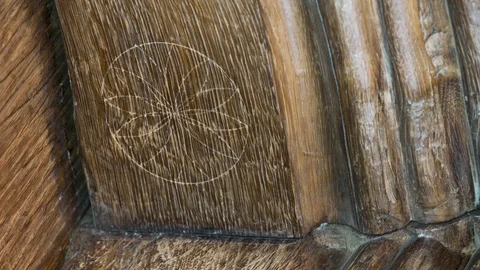
The marks burn into the wood include a 'petal circle'. A craftsman's compass and scriber mark.
What can you discover as you walk about the hall?
The burn marks can be spotted on a visit around Little Moreton Hall and our friendly staff are on hand to tell you more about them. Why don’t you see how many you can find on your next visit? You might also spot a couple of sets of concentric circles former residents at Little Moreton Hall scored into the wood to trap evil spirits. The carpenters who built the Hall also added their own form of witch traps which our guides can point out to you… providing you keep them a secret from the witches.
The People. The Moretons.
(Extract from National Trust notes.)
You would be forgiven for thinking there wasn’t a lot to shout about.
The Moretons have disappeared into history, leaving very little behind
apart from the iconic building they created and a few pieces of furniture.
However, as more evidence comes to light, we’re finding that
this family has a fascinating story to tell.
It is clear they were wealthy and keen to assert themselves locally.They were a powerful family
who bought up significant amounts of land following the Black Death and later the Dissolution of the Monasteries.
The resulting wealth allowed them to build the ostentatious Little Moreton Hall. Building started in 1504 under
the first William Moreton, and the house was built in stages, completed around 100 years later.
Illustration: A Tudor Pun - the Maw (wolf's head) and Tun (barrel) underneath used to pictorially represent the family name of Moreton
Aside: It is from the 'ton' barrel that the English weight measure 'Ton' derives.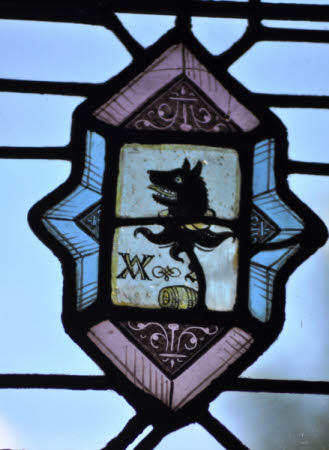
National Trust Images/James Dobson, A Tudor Pun - the Maw (wolf's head) and Tun (barrel) used to pictorially represent the family name of Moreton
Decline in wealth and fortunes.
The Civil War saw a dramatic change in the family’s fortunes. They were associated with the Royalist cause in a region that was dominated by Parliamentarians. As a result, William Moreton III was imprisoned in the early stages of the war and not allowed to return to his estate upon his release. The running of the household was left to his two daughters Anne and Jane. The Hall was confiscated by the government and the two women rented it back at an extortionate rate. They even had to tolerate their home being used by Parliamentarian soldiers and their horses. By the time William returned to the Hall, he had no hope of paying back his debts before his death. No longer the showpiece of a rich and prospering family, the hall fell into decline over the next 250 years.
After the death of the William Moreton III, the care of the Hall fell to his children. Their generation of the family was the last to live permanently at the Hall. The house was then rented for over 200 years, first to relatives and then to a succession of tenant farmers. In many respects, we owe the survival of the hall to its neglect during these years. With little interest from the owners, the Tudor building survived in its original state rather than being modified to suit more ‘modern’ tastes.
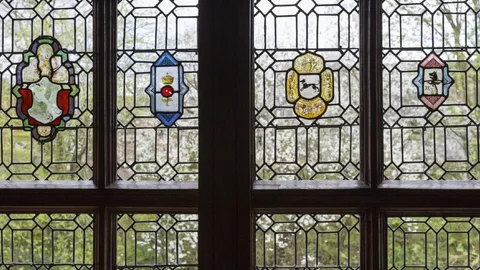
Expensive display of Glass Windows.
At the time of building the hall, glass was an extremely expensive item,
so windows with glass were usually very few, but Little Moreton Hall
has a vast amount of glass windows, with many in the expensive stained glass style showing images.
A very visible display of wealth.
Little Morton Hall has over 200 stained glass images.
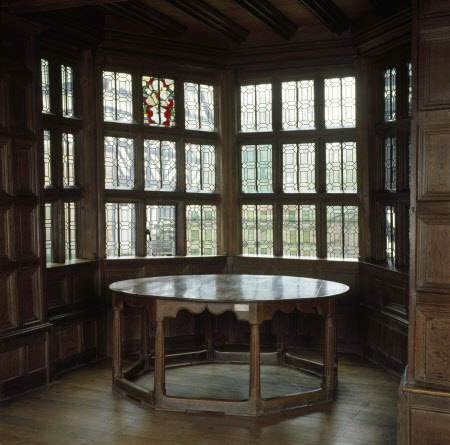
One of the two bay windows.
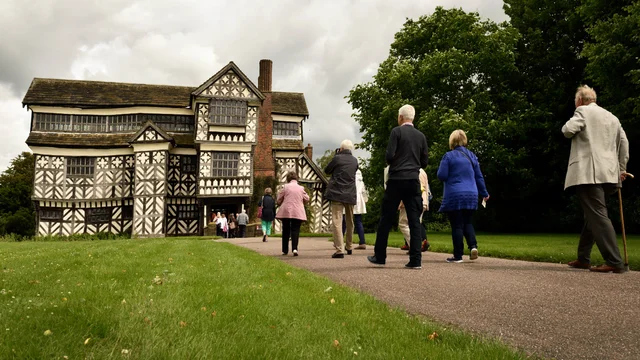
The Hall with its many windows and 'wonky' appearance.
Building is ‘wonky’
Extending a building by adding a very heavy upper story with tons of tiles as in “the Long Gallery” without making stronger foundations
causes problems as all modern day DIY folk know.
Little Moreton Hall is incredibly wonky!
What caused the subsidence of the building?
It might not be marshy ground as was once thought. Neil, a building surveyor and room guide at the Hall, explains.
It has long been suggested that marshy ground was the cause of the extensive settlement of the building. However, we have photographic evidence that trial hole excavations in the orchard proved to be dry. If the ground had been “boggy”, the holes would have rapidly filled with water. There is evidence that the moat was clay puddled, to seal against leakage, suggesting that the ground was free draining and would not hold water.
Instead, we suggest that much of the settlement was due to the late addition of the long gallery, with no provision having been made for the additional load in the ground and first floor structures below. Distortion of the first floor ceilings are clear. Further, new oak inserts are evident at the base of many external wall posts, where rotted posts have been repaired, but not before settlement had already taken place. These factors, plus natural movement and settlement of the frame, probably account for the distortion of the building.
Recommended visit to a website. Many Illustrations are on the National Trust Website
You can see the items in the collection that the Moretons left behind by following the link below.
Images of items at Little Moreton Hall (link) Images are at very bottom of four pages of images..
https://www.nationaltrustcollections.org.uk/results?SearchTerms=Little+Moreton+Hall&ImagesOnly=True
Wikipedia entry with hall diagram of buildings.
https://en.wikipedia.org/wiki/Little_Moreton_Hall
REFERENCES. & Links.
Little Moreton Hall Cheshire
https://www.nationaltrust.org.uk/little-moreton-hall
Little Moreton Hall's collection
Find objects in the collection
http://www.nationaltrustcollections.org.uk/place/little-moreton-hall
The National Trust (in England & Wales)
National Trust https://www.nationaltrust.org.uk
Membership is by an annual fee and gives entry to all National Trust Properties in England and Wales ,
andalso gives entry to all properties of The National Tust for Scotland.
National Trust for Scotland
https://www.nts.org.uk/
Thanks.
The members and visitors give to our entertaining speaker Mr Trevor Williams our most heartfelt thanks for a pleasant and enjoyable evening.
A reminder, he advises all of our members and website viewers to visit theLittle MoretonHall in person if possible.
